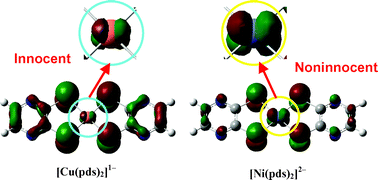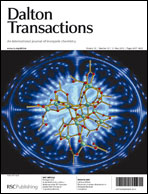In this paper we present an experimental and theoretical study to investigate the electronic structures of [ML2]− (M(III) = Cu, L = pdt and pds, pyrazine-2,3-dithiolate and -diselonate; M(III) = Au, L = pds) with the aim of elucidating the nature of the bonding and to establish the innocent–noninnocent character of the ligand in these complexes. Calculations based on DFT methods have been performed to obtain geometry optimizations, harmonic frequencies, IR intensities and Raman scattering activities. The experimental vibrational spectra are accurately reproduced by the calculations, which show that CC, CN, and CX (X = S, Se) vibrations are extensively mixed with other modes, and thus unsuitable to work as vibrational markers. Geometry optimization performed at the DFT level provides geometrical parameters in good agreement with the available structural data. The energetic sequence and nature of the redox-active molecular orbitals help to elucidate the observed electrochemical behaviour. Accordingly, the quasi-reversible redox couple for the reduction processes exhibited by [ML2]2− (L = pdt and pds), that appears at negative values and depends both on the ligand and on the metal, is related to the LUMO which is a σ antibonding combination of the ligand orbitals (sulfur or selenium atoms) and the 3dxy (Cu) and 5dxy (Au) metal orbitals. The HOMO is a π-orbital with a b2g symmetry, predominantly ligand in character with a small contribution of the ndxz atomic orbitals in antibonding combination with chalcogen atom orbitals. The low energy of the metal d-orbitals compared to the ligand orbitals, due to the high effective nuclear charge of the metals, explains their small participation to this orbital. Thus in [ML2]− the metals approach the oxidation state 3+ and the ligand a dichalcogenolate description and thus a prevalent innocent character. However the same ligand shows a noninnocent character in complexes with a different d8 metal such as Ni(II) whose d-orbitals lie at higher energies and mix at a higher extent with the ligand orbitals in the HOMO.


 Please wait while we load your content...
Please wait while we load your content...